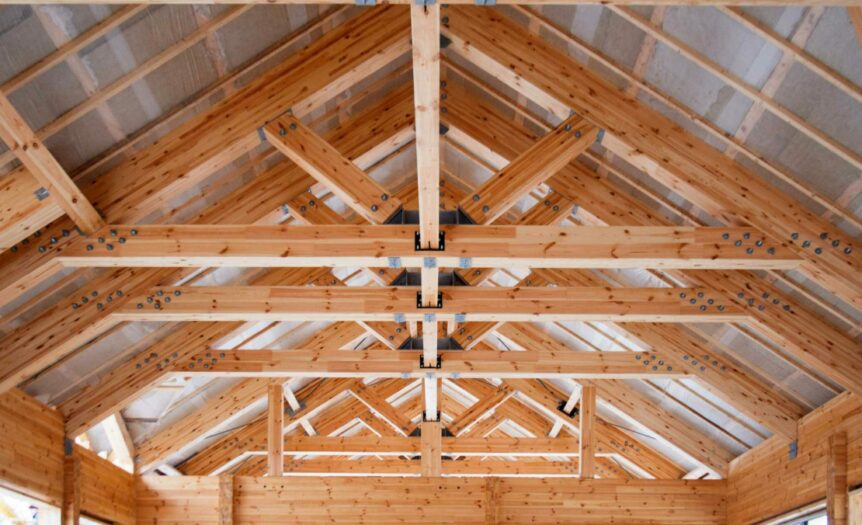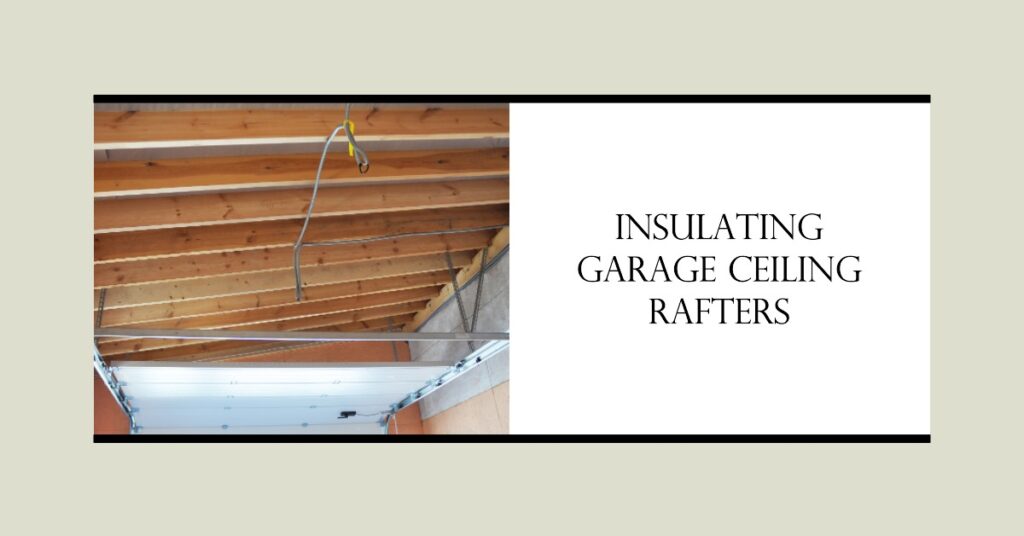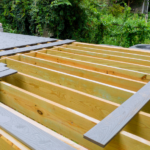The importance of a well-insulated garage cannot be overstated, especially when it comes to your home’s overall energy efficiency and comfort. One crucial area often overlooked is the garage ceiling rafters which, when properly insulated, can significantly reduce heat loss and save you money on utility bills in the long run.
Whether your goal is to create a comfortable workspace or simply protect parked vehicles from extreme temperatures, insulating your garage ceiling rafters is an essential home improvement project worth investing in.
Key Takeaways
- Insulating your garage ceiling rafters can significantly improve energy efficiency, lower utility costs, reduce noise transmission and protect stored items from temperature fluctuations.
- There are different types of insulation materials available for garage ceiling rafters, including fiberglass batts, rigid foam boards, spray foam and radiant barrier. Choose the one that best suits your needs and budget.
- Before starting the insulation process, prepare the area by cleaning out debris or stored items in the space and checking for any structural concerns like water damage or rodent infestations.
- Once you have installed insulation between each rafter bay of your garage ceiling rafters, seal any gaps with caulk or expandable spray foam to prevent drafts. Additionally, insulating walls and doors of your garage will further increase its energy efficiency.
Benefits Of Insulating Your Garage Ceiling Rafters
Insulating your garage ceiling rafters can provide a range of benefits such as improving energy efficiency, reducing utility costs, reducing noise transmission, and protecting stored items from temperature fluctuations. When working on insulating a garage ceiling with rafters, don’t forget to consider the decorative touch that gable brackets can add.
Improved Energy Efficiency
One of the primary benefits of insulating your garage ceiling rafters is the significant improvement in energy efficiency. Proper insulation prevents heat from easily escaping through the roof during colder months, and conversely, keeps cooler air inside during hot summers.
As an example, let’s consider a detached garage converted into a workshop or playroom. With ample insulation in place between the rafters – such as fiberglass batts or rigid foam – you’ll likely notice a stable indoor temperature all year round without having to constantly rely on additional heating or cooling sources.
Reduced Utility Costs
Insulating your garage ceiling rafters can significantly reduce utility costs. When a garage isn’t insulated, the space typically remains at the same temperature as outside.
This means that during extreme temperatures, such as a hot summer or a cold winter, your heating and cooling systems have to work harder to maintain comfortable temperatures indoors.
By insulating your garage ceiling rafters with materials such as fiberglass batt or rigid foam, you can prevent heat loss in the winter and keep cool air inside during the summer months.
As a result, this will help lower energy consumption and ultimately reduce utility bills.
Reduced Noise Transmission
Insulating your garage ceiling rafters does more than just improving energy efficiency and lowering utility bills. One of the significant benefits of insulation is reduced noise transmission between your garage and the rest of your home.
By adding rigid foam insulation to your garage ceiling rafters, you can significantly reduce vibrations that cause noise to pass through walls and ceilings. The insulation absorbs sound waves before they have a chance to bounce off hard surfaces like walls and ceilings, making it easier to go about daily activities without disturbing others around the house.
Reduced noise transmission not only provides peace for people residing in other parts of your home but also adds value by making a comfortable environment for everyone involved.
Protection For Stored Items
As a homeowner, you may use your garage for more than just parking vehicles. Some people utilize their garages as storage spaces for tools, equipment, and other valuable items.
By insulating your garage ceiling rafters with fiberglass batt or rigid foam insulation, stored items can enjoy protection from extreme weather conditions such as intense heat or cold.
Insulation also helps maintain consistent temperature levels in the garage to prevent damage to sensitive items such as paint cans or electronics.
In addition to protecting stored items from adverse weather conditions and changes in temperature, insulating your garage ceiling rafters has numerous other benefits outlined above regarding improved energy efficiency and reduced utility costs which can save homeowners’ money on their energy bills while increasing home value.
Different Types Of Insulation For Garage Ceiling Rafters
Learn about the different types of insulation materials available for your garage ceiling rafters, including fiberglass, rigid foam, spray foam, and radiant barrier to make an informed decision for your home improvement project.
Fiberglass
In my experience, one of the most popular options for insulating garage ceiling rafters is fiberglass batt insulation. It’s affordable and relatively easy to install, making it a favorite among DIY enthusiasts.
One thing to keep in mind when installing fiberglass insulation is that it can cause skin irritation or respiratory problems if you’re not wearing protective gear like gloves, goggles, and a mask.
Additionally, fiberglass insulation can settle over time, reducing its effective R-value. To avoid this issue, use compression-resistant batts made specifically for ceilings or floors.
Rigid Foam
I highly recommend using rigid foam insulation for insulating your garage ceiling rafters. This type of insulation has a high R-value, which means it can effectively prevent heat loss and provide excellent thermal performance.
There are two types of rigid foam insulation available: expanded polystyrene (EPS) and extruded polystyrene (XPS). Both are great options for insulating garage ceilings. EPS is cheaper but has a lower R-value than XPS.
XPS is more expensive but provides better insulation and moisture resistance.
Spray Foam
Spray foam insulation is an excellent option for insulating garage ceiling rafters due to its high R-value and air-sealing properties. Spray foam acts as both an insulator and a sealant, filling up any gaps or cracks in the ceiling that other types of insulation may miss.
One thing to consider when using spray foam is the cost. It tends to be pricier than other forms of insulation, such as fiberglass batts or rigid foam panels. However, spray foam provides better long-term savings by reducing energy costs and maintaining consistent indoor temperatures throughout the year.
Radiant Barrier
For those looking for a highly effective type of insulation to use when insulating their garage ceiling rafters, radiant barrier is worth considering. This type of insulation material reflects heat instead of absorbing it, making it ideal for garages located in hot climates.
When properly installed, a radiant barrier can reduce the amount of heat that enters your garage by up to 97%. The best part about using this material is that it doesn’t take up much space and won’t interfere with storage or living space in your garage.
To install radiant barrier insulation, start by measuring the length and width of your ceiling rafters. Next, cut the foil into sections that are slightly larger than each rafter bay.
Then staple or tape them onto the sides and bottom surfaces of each rafter bay ensuring they touch as little outside air as possible. Be sure to keep any areas overlapping tightly pressed together so that no gaps are left unsealed where heated air could come through during winter months if you live in colder climates.
How To Insulate Your Garage Ceiling Rafters: A Step-by-Step Guide
To effectively insulate your garage ceiling rafters, start by measuring the area to determine insulation needs, then prepare the space for installation and choose the right material such as fiberglass batt or rigid foam before installing it, sealing any gaps or cracks in-between to maximize energy efficiency.
Measure And Assess Your Insulation Needs
Before insulating your garage ceiling rafters, you need to measure and assess your insulation needs. Start by calculating the area of the ceiling and taking note of any obstructions such as wiring or ventilation systems.
Then determine the R-value, which measures how well insulation resists heat flow, needed for your climate zone and whether you want to add more than the minimum requirement for increased energy efficiency.
If you’re unsure about what type of insulation would work best for your garage ceiling rafters, consult with a professional or research online. Fiberglass batts or rigid foam are popular options because they fit between standard stud cavities.
However, if you live in an area with high humidity or moisture concerns, spray foam might be a better choice as it creates an air barrier that is less susceptible to water damage.
Prepare The Area For Insulation
Before beginning the insulation process, it is essential to prepare the garage ceiling rafters. This step involves cleaning and clearing out any debris or stored items in the area.
It’s also necessary to cover your skin and eyes with protective gear such as gloves and safety glasses.
Additionally, check for any structural concerns before starting. Look for signs of water damage, rodent infestations, or mold growth on the roof deck.
Taking care of these preparations will ensure a safer and more efficient insulation process overall.
Choose The Right Insulation Material
When it comes to insulating your garage ceiling rafters, choosing the right insulation material is crucial. There are different types of insulation materials available in the market, such as fiberglass batts, rigid foam boards, spray foam and radiant barrier.
Fiberglass batt insulation is a popular choice for homeowners because it’s affordable and easy to install.
Rigid foam boards are another option that provides high levels of insulation.
Spray foam offers the most robust insulation on the market and fills even the most challenging spaces entirely.
Ultimately, choosing the right material depends on various factors like budget considerations, local building codes requirements room usage intentions after insulating (i.e., storage vs converting them into a liveable part of your home).
Install The Insulation
Once you have prepared the garage ceiling rafters and chosen the appropriate insulation material, it’s time to install.
If installing fiberglass batt insulation, simply measure each rafter and cut the batt to fit snugly between them.
For those considering rigid foam or spray foam insulation, it may be best to hire a professional installer due to their expertise in working with these materials.
Remember also that any gaps between your rafters will need insulating too – this can be done using strips of leftover insulation material or caulk for smaller areas.
Whichever method you choose, take necessary safety precautions during installation such as wearing protective gear and being aware of electrical hazards.
Seal Any Gaps Or Cracks
Once you have installed insulation, the next step is to seal any gaps or cracks. Even small openings can allow air to penetrate and reduce the effectiveness of your insulation.
Check for gaps around electrical boxes, pipes, vents, and any other penetrations in the ceiling. Use a caulking gun to seal smaller openings with silicone caulk or expandable spray foam insulation.
It’s essential to ensure that there is adequate ventilation in your garage once you seal it up; this will prevent moisture buildup and improve indoor air quality. If necessary, install roof vents or install an exhaust fan to increase airflow when needed.
Additional Tips For Insulating Your Garage
Seal any gaps or cracks with weatherstripping to prevent drafts and add a garage heater for optimal results in keeping your garage warm during winter months.
Insulate Garage Walls And Doors
To further improve the energy efficiency of your garage, it’s essential to insulate not just your ceiling rafters but also your walls and doors. This will help maintain a comfortable temperature and reduce heat loss in winter while keeping hot air out during summer months.
In addition to providing better insulation, insulation of garage walls and doors also helps reduce noise transmission from outside the garage into your home. A well-insulated garage is known for its quietness, making it easier to work on projects without disturbing others in the household.
Use Weatherstripping To Seal Gaps
Another critical aspect of insulating your garage ceiling rafters is sealing any gaps or cracks that may exist. Gaps and cracks can compromise the efficiency of the insulation by allowing air to escape from the room, reducing its effectiveness at regulating temperature and sound transmission.
Weatherstripping comes in many different forms, including adhesive strips, tapes, or caulking. These materials are usually easy to apply and come with clear instructions on how to use them correctly.
By filling in any visible openings around windows, doors or vents with weatherstripping tape you’ll help prevent cold air drafts from entering your garage space.
Using quality weatherstripping will strengthen the insulation barrier between outside temperatures and the inside of your home while preventing pests like mice from making their way inside through these gaps as well!
Add A Garage Heater For Optimal Results
As someone who lives in a colder climate, I understand the struggle of trying to keep a garage space warm during the winter months. While insulating your garage ceiling rafters is an essential first step towards improved energy efficiency and reduced utility costs, adding a garage heater takes things to the next level.
There are several options when it comes to choosing a garage heater, ranging from infrared heaters that provide focused heating to forced-air models that distribute heat via vents throughout your space.
It’s important to note that while these heaters can be incredibly efficient, they do require proper ventilation and installation for safety reasons. Consulting with an HVAC contractor before selecting and installing a heater is always recommended.
Safety Considerations When Insulating Your Garage Ceiling Rafters
When insulating your garage ceiling rafters, it is essential to wear protective gear, be aware of any electrical hazards, and inspect for structural concerns to ensure a safe and successful insulation installation.
Wear Protective Gear
As you prepare to insulate your garage ceiling rafters, it’s essential to keep safety in mind. Insulation materials can be hazardous to your health, so wearing protective gear is crucial.
Before getting started with the insulation process, make sure that thick gloves and a dust mask adequately cover your hands and nose as you handle the insulation material.
Furthermore, while working on any insulation project, it’s best practice to have eye protection goggles on hand to ensure no fibers enter your eyes accidentally.
Be Aware Of Electrical Hazards
It’s essential to be aware of electrical hazards when insulating your garage ceiling rafters. Ensure that the power supply is entirely disconnected before attempting any insulation work, as you don’t want to suffer an electric shock or start a fire accidentally.
Make sure that all wiring and cables are secure and correctly insulated before starting work on the rafters. Check for electrical hazards such as exposed wires, faulty circuits, or overloaded outlets.
It’s also advisable to install smoke detectors in your garage if you haven’t already done so.
Check For Structural Concerns
Before insulating your garage ceiling rafters, it is essential to check for any structural concerns that may exist. This step ensures the safety of your home and loved ones while also protecting your property from potential damage.
Additionally, be sure to inspect the electrical wiring and fixtures in your garage before beginning the insulation process. Check whether any wires are exposed or damaged as this can pose a dangerous fire hazard when covered with insulation material.
By being diligent in checking for these issues beforehand, you can ensure a safe and successful insulation process that will allow you to enjoy all of its benefits without worry.
Conclusion
Insulating your garage ceiling rafters is a worthwhile investment that can bring multiple benefits to your home. Whether you want to reduce energy costs, prevent heat loss or protect stored items, proper insulation is essential.
With various insulation materials and methods available, it is crucial to choose the right one for your needs and follow safety guidelines throughout the project. By following our step-by-step guide, you can insulate your garage ceiling rafters safely and efficiently while adding value to your property.
FAQs:
1. Why should I insulate my garage ceiling rafters?
Insulating your garage ceiling rafters can help regulate the temperature inside, making it more comfortable to use year-round and potentially reducing energy costs.
2. What materials should I use for insulating my garage ceiling rafters?
Fiberglass insulation batts, spray foam insulation or rigid foam boards are common options for insulating a garage ceiling. The best choice depends on the specific needs of your home and budget.
3. How do I properly install insulation in my garage ceiling rafters?
For fiberglass batts, carefully cut them to size and fit them between each rafter in the ceiling space before stapling them into place using a staple gun. For spray foam or rigid foam board installations, follow manufacturer instructions closely and consider consulting with an expert contractor for assistance.
Related Posts
How many square feet is a 2 car garage?
Can you store paint in the garage?
Should i insulate my garage?
How to clean Expoxy Garage Floor?
How to get a Hummingbird out of a garage?
How long do garage door openers last?









